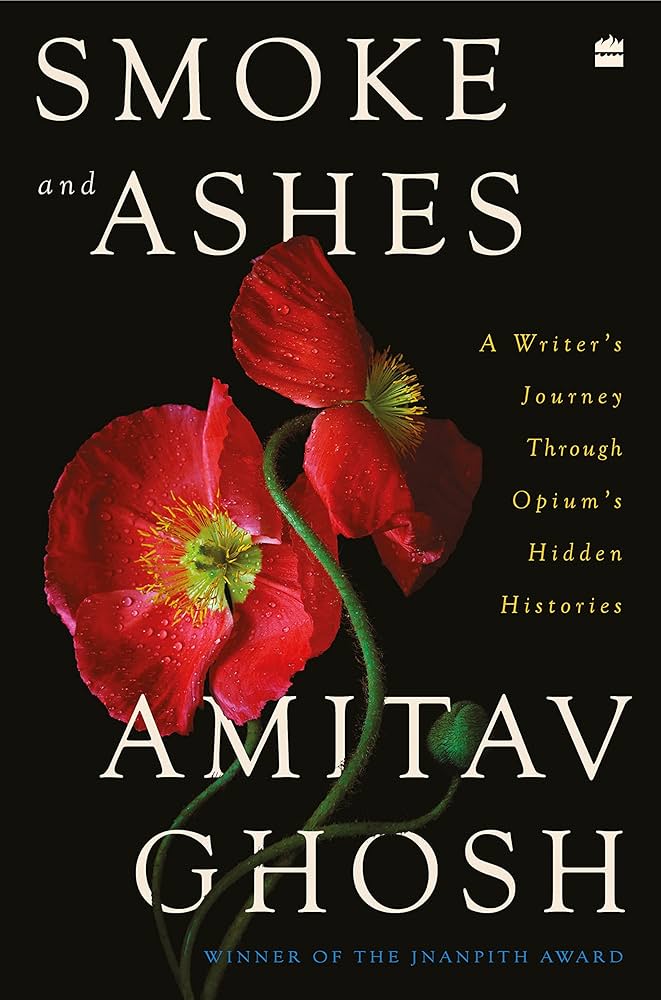
Amitav Ghosh’s Smoke and Ashes: A Writer’s Journey Through Opium’s Hidden Histories, published by Fourth Estate India in 2023, has been variously described as a travelogue, a memoir, and an “excursion into history” (p. 697). If the expanse of these genres is vast, so is Ghosh’s project. It straddles three centuries and moves across several continents, tugging at the limits of the colonial archive and recounting the ‘story’ of the opium poppy, which he articulates as “a historical force in its own right” (p. 54). In doing so, Ghosh unearths the research he conducted for The Ibis Trilogy, the critically acclaimed historical fiction documenting the opium trade between colonial India and China. On the level of argument, Smoke and Ashes is also a continuation of Ghosh’s recent work–an effort to decenter the Anthropocene and accept the power of non-human entities as active agents dictating the course of history.
Through Ghosh’s examination, we witness the opium poppy as shaping major narratives in the subcontinent in the 19th and 20th centuries, and the long-term consequences it continues to have for the region in the 21st. We see the plant’s might, as Chinese authorities struggle to control its usage and smuggling, while Imperial Britain systematically creates a market for it, earning massive revenues in the process. The British used the plant to assert their authority over the Indian Ocean, ruthlessly controlling its flow and forcing the Chinese to accept its imports.
Contrary to the silence in popular discourse, Ghosh is pointedly assertive about the empire’s dependence on opium as a source of income. The net earnings from opium were probably higher than those from land and salt taxes, prompting Ghosh to term it the “pillar of empire” (p. 449). Opium, the book points out, played an important role in sustaining colonialism in Asia–a fact conveniently erased from most historical records.
Ghosh’s archive is massive and his examination is acute. The book is simultaneously a tussle with the limits of the archive, along with a flight into its possibilities. Ghosh’s archive is varied– imperial documentation, records, and newspapers. It’s also family paraphernalia, teacups, photographs, and oral histories. Fiction from the 20th century– a Bhojpuri novel called Phoolsunghi. We are given an insight into the Orientalist mind with Kipling’s essays, along with essays written by the Tagore family. Ghosh manages to also illuminate for the reader how the English language occluded colonial practices. When Ghosh does not find an equivalent record in Indian languages, he shifts to another material archive. He turns to images made by Indians and Englishmen–the contrasting depictions which reveal to Ghosh the startling difference between representations created by the colonized and the colonizer.
His methodology is varied. Literary criticism, travel, historical and sociological analysis– all these yield several levels of hidden histories. This historiography of a ‘plant’ inevitably runs into conceptual barriers. Ghosh writes, “it is very difficult to narrate a story in which a botanical entity is both instrument and protagonist” (p. 529). This postcolonial analysis of the archive conjures possibilities that have far-reaching consequences. One of the most moving sections in the book is the history of the region known as Purvanchal, as Ghosh painstakingly explains the poverty of Bihar through the pain of the farmers forced to grow opium so the British could continue to trade with China. The coercive mechanisms of the colonial narco-state are illuminated by the deftness of Ghosh’s analysis, which refuses to bow down to any narrative of Western ‘progress’ and rallies hard against it.
Ghosh places his project at the intersection of the past and present – elaborating for us the opium economy of the British imperial state, the current state of opioids in the United States, and the growing cultivation in Mexico despite rigorous eradication efforts. In this meticulous narration, he questions our insistence on believing humans to be the “only agents of history” (p. 527). A crucial question emerges–what is at stake in acknowledging opium poppy’s role in history? In Ghosh’s own words, “to do so would mean parting company with many ideas that have long been dominant, such as the notion that the earth is in and humans are the only agents in history” (p. 527). This thesis is in continuation of Ghosh’s earlier work, including his meditations on climate change in The Great Derangement (2016), and his narrative of the nutmeg spice in The Nutmeg’s Curse (2021). Ghosh’s overarching argument across the oeuvre is an important intervention in the story of our world. He reminds us that there are non-human protagonists in that which we call ‘history’.
***
Vinky Mittal is a Writing Tutor at the Centre for Writing and Communication, Ashoka University.
[…] post Smoke and Ashes: A Writer’s Journey Through Opium’s Hidden Histories by Amitav Ghosh (2023): A R… appeared first on Doing […]